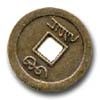
According to tradition, I Ching is consulted by using the 50 yarrow stalks. This long process is based on the use of 3 coins or 3 small sticks.
The 3 coins are cast 6 times whilst the question is formulated. There are 4 possible combinations:

Yang Coin

Yin Coin
6 = the broken changing Yin line, 7 is the fixed unbroken Yang, 8 = fixed, broken Yin and 9 = solid changing Yang. The Hexagram is formed from top to bottom so the first line is at the bottom and the sixth line is at the top.
The solid lines are unchangeable whereas the broken lines can form a second hexagram. The broken line and the solid line and the solid line and the broken line therefore form a second hexagram. It's also possible to let I Ching comment on the current situation without even asking the question
If an answer has been given by throwing coins, the hexagram obtained represents the answer in the context of the current situation. The most important aspects are the Image, the Sentence and the Lines, especially those that are mobile. The Image introduces the hexagram as a combination of 2 trigrams and shows the situation at the same time as the question was asked.
The Sentence "focuses on" the subject and gives an indication depending on the possible choices which need to be made to do the right thing or avoid disgrace. The circumstances can be good or bad but it's important to keep in mind an excellent strategy to deal with them.
One of the most surprising characteristics of I Ching is that it often manages to succinctly describe the situation in which we are in, even in modern times. The Oracle can give us courage and makes things clearer. Consulting I Ching therefore is a way of better understanding the contingent situation and alleviates our worries for the future by making the right choices. The I Ching helps us to be the author of our own destiny, guaranteeing us being in harmony with the world around us.

 Ctrl+D to bookmark us
Ctrl+D to bookmark us